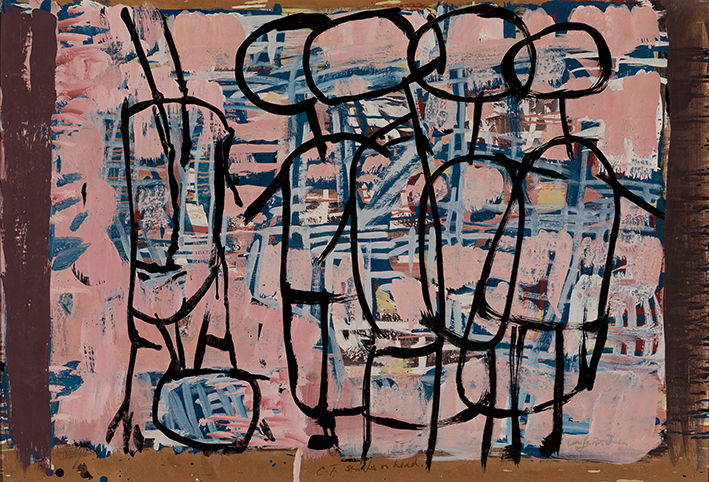Ian Fairweather: The Drunken Buddha
One of Australia’s most important and influential artists, Ian Fairweather’s style is unique. A combination of abstraction and figuration joined through a meandering use of the line, Fairweather’s paintings use a limited palette of blacks, greys, blues, pinks and browns. Marks are made in and through layers of paint that are as much in conversation with Chinese calligraphy as they are with Aboriginal mark making and mid-twentieth century abstraction.
His was a life of journeys—China, India, Canada, Bali, Australia—and these experiences pervaded his art practice. Most famously, on the night of 29 April 1952, aged sixty, Fairweather sailed his homemade raft out of Darwin. The journey lasted 16 days until he collided with a reef off the coast of Timor. In 1953 he settled on Bribie Island, near Brisbane, where he built a Polynesian style hut. This is where The Drunken Buddha paintings were created.
Fairweather began his study of Mandarin when he was a student in London at the Slade and carried a Mandarin dictionary with him almost his whole life. He translated the centuries old Chinese devotional tale about a monk named Chi-tien from Mandarin to English, and though initially reluctant, eventually created a series of interpretative artworks to accompany the text. Fairweather’s translation of The Drunken Buddha tale was published by the University of Queensland Press in 1965 and an associated exhibition was held at Macquarie Galleries, Sydney from 12 to 24 May of the same year. Fifty years later, the book has been reprinted by the University of Queensland Press on the occasion of our exhibition at TarraWarra Museum of Art.
Like the Buddhist monk Chi-tien, Fairweather was unconventional. They both prospered from living life to the full and allowed their own beliefs, values and philosophy to dictate the way they lived and created. Fairweather painted on cardboard and other transient materials with hardware paint and toothpaste. He preferred to use the roll of canvas sent from Macquarie Galleries to fix the roof on his Bribie Island Hut rather than paint on it.
Fairweather’s paintings depict great acts of the everyday that hold considerable weight in the story of an irreverent saintly figure. In addition, they are in continual flux, exhibiting a rhythmic dynamism that seeks at once to express the character of this adventurous monk as well as the painterly exploration of skeins of lines and passages of paint on cardboard and hardboard. The figurative elements are almost like Chinese ideograms, while the layers of paint form a generative mosaic that periodically rises to the surface. These works are grounded, connected to the earth and are humble, they subsist in a duality of the earth and the heavens; which is the domain of Chi-tien.
